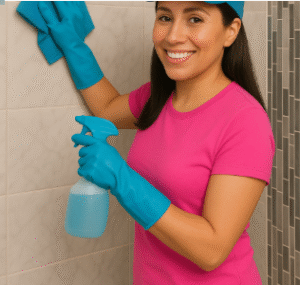Imagine a world where keeping your home spotless doesn’t come at the cost of the environment. For many, this might seem like a distant dream, yet a quiet revolution is happening right under our noses. The cleaning aisle, once dominated by harsh chemicals and strong synthetic fragrances, is being transformed by a new wave of eco-friendly home cleaners. These innovative products not only promise to clean your living spaces effectively but also ensure that you’re doing your part to protect our planet. As more people wake up to the environmental impact of their daily choices, switching to greener cleaning alternatives is becoming a compelling option for households worldwide.
The numbers don’t lie; the market for sustainable cleaning products is projected to grow significantly over the next decade, as consumers become increasingly aware of their ecological footprint. With options ranging from biodegradable soaps to packaging made from recycled materials, these eco-friendly home cleaners are not just a trend—they’re a testament to a broader shift towards sustainability. In a world where every action counts, embracing these green alternatives can make a tangible difference in our quest for a healthier planet, without having to compromise on cleanliness. Join us as we explore ten groundbreaking products that are redefining the cleaning landscape, one environmentally-conscious swipe at a time.
The Rise of Eco-Friendly Home Cleaners
Over the past decade, a significant movement toward greener living has swept through households worldwide, driving the rise of eco friendly home cleaners. What began as niche offerings from small-scale artisans and local co-ops has burgeoned into a booming segment of the consumer goods market. Brands large and small are investing in research, development, and marketing to position their formulas as both environmentally responsible and highly effective at combating dirt, grime, and germs. These new products often boast plant-derived surfactants, natural essential oils for fragrance, and zero-to-xylene solvents, demonstrating that green alternatives can rival—or even outperform—their chemical-laden predecessors.
Factors fueling this meteoric rise include increased awareness of indoor air quality, worries about endocrine-disrupting ingredients, and government regulations aimed at reducing toxic waste. Online communities and eco-blogs have amplified tales of respiratory issues linked to conventional cleaners, prompting many households to investigate safer substitutes. Retailers have responded by stocking dedicated “green cleaning” shelves, and big-box stores now feature lines certified by third-party organizations such as ECOLOGO and EPA’s Safer Choice. As more consumers demand transparency about ingredients and lifecycle impacts, eco friendly home cleaners have emerged from the fringes to become a mainstream staple in cleaning cupboards everywhere.

Katy’s Joyful Staff
Benefits of Using Sustainable Cleaning Products
Switching to sustainable cleaning products delivers a spectrum of benefits that extend far beyond basic surface shine. First and foremost, these eco-friendly home cleaners minimize exposure to volatile organic compounds (VOCs) and harsh chemicals that can irritate skin, eyes, and respiratory systems. Families, especially those with children or individuals prone to allergies and asthma, can breathe easier knowing that the cleaning agents they bring into their homes won’t linger as harmful residues or produce noxious fumes. Moreover, many green cleaners are formulated without artificial colors or fragrances, relying instead on plant‐based essences that are gentler on both users and the environment.
Environmental advantages are equally compelling: sustainable formulations often incorporate biodegradable surfactants and enzymes that break down quickly in waterways, reducing the risk of aquatic toxicity. Packaging innovations—reusable bottles, concentrated refill pods, and post-consumer recycled plastics—further shrink the carbon footprint associated with production and disposal. In the long run, investing in concentrated or refillable eco friendly home cleaners can also lead to cost savings, since fewer shipping miles and less packaging waste go hand in hand with competitive per-use pricing. Ultimately, choosing sustainable cleaning solutions supports healthier homes and planet-friendly practices in one straightforward step.
Understanding Key Ingredients in Eco-Friendly Cleaners
At the heart of eco-friendly home cleaners lie carefully chosen ingredients that deliver cleaning power without the harmful side effects of synthetic chemicals. Common components include plant-based surfactants derived from coconut or corn, which effectively loosen dirt and grease. Natural chelating agents like citric acid bind to mineral deposits, ensuring spotless glass and stainless steel surfaces. Instead of phthalates or artificial dyes, many green formulations use essential oils—such as lemon, tea tree, or lavender—for both their antibacterial properties and pleasing natural aromas.
Understanding how these ingredients work helps consumers make informed choices. Enzymes, for instance, target specific stains (proteins, starches, or fats) by catalyzing their breakdown at a molecular level, offering superior stain removal with minimal environmental impact. Meanwhile, natural alcohols sourced from sugarcane or grain act as disinfectants, matching the germ-killing efficacy of traditional isopropyl alcohol. By prioritizing renewable, biodegradable components, eco friendly home cleaners ensure that every swipe, scrub, or spray contributes to a cleaner home and a healthier ecosystem.

Top Eco-Friendly All-Purpose Cleaners
When it comes to versatile cleaning power, certain eco-friendly home cleaners stand out for their ability to tackle multiple surfaces without harsh residues. Here are five standout all-purpose solutions that balance performance with planet-friendly credentials: 1. GreenWave Botanical Spray – Plant-based surfactants and citrus enzymes work on everything from countertops to ceramic tiles. 2. Pure Planet Concentrate – Ultra-concentrated with refill pods to cut plastic waste and shipping impact. 3. EarthKind Multi-Surface Cleaner – Fragrance-free, hypoallergenic, and certified by Environmental Working Group. 4. BioBrite Naturally Clean – Infused with grapefruit seed extract for natural disinfection. 5. ReNature Citrus Foam – Gentle on stone surfaces and made with 100% recycled PET bottles.
These all-purpose champions not only reduce clutter by replacing multiple single-surface products but also simplify eco-friendly living. With formulations free of bleach, ammonia, and synthetic perfumes, each spritz leaves surfaces gleaming without the chemical haze. Whether you’re wiping down stainless steel appliances or refreshing your bathroom vanity, these versatile eco friendly home cleaners prove that sustainability and functionality need not be mutually exclusive.
Innovations in Biodegradable Soaps and Detergents
Recent advances in biodegradable soaps and detergents are reshaping the way we approach laundry, dishwashing, and general cleaning tasks. Traditional powder and liquid detergents often rely on phosphates, sulfates, and optical brighteners that can persist in wastewater, posing risks to aquatic life. In contrast, modern eco-friendly home cleaners feature enzyme-driven formulas and non-ionic surfactants that break down rapidly under natural microbial action. These ingredients deliver high-performance cleaning while ensuring that wastewater treatment plants can more effectively process and neutralize byproducts.
Leading brands have introduced dissolvable detergent sheets, compostable pods, and ultra-concentrated liquids, all designed to minimize packaging volume and reduce shipping weight. Some enzyme blends target specific stains—lipid-busting for oily residues, protease for grass and blood, and amylase for starch-based spills—offering a precise approach that cuts down on overuse. By adopting these biodegradable soaps and detergents, environmentally conscious households can maintain bright whites and sparkling dishes without contributing to the load of persistent pollutants in freshwater systems.
Revolutionizing Cleaning with Plant-Based Formulas
Plant-based formulas represent the next frontier in green cleaning, harnessing botanical extracts and natural acids to deliver powerful results. Ingredients like sophorolipids (fermented sugars from coconuts), saponins (extracted from soapberry), and citric acid (sourced from citrus fruits) are all star performers in the plant-powered toolkit. These bioactive compounds disrupt grease and grime at the molecular level while remaining gentle on surfaces, fabrics, and skin. The shift toward such botanicals also means fewer petroleum derivatives, aligning product lifecycles more closely with renewable agricultural cycles.
Manufacturers are now incorporating novel plant-based antimicrobials—such as thyme oil, clove oil, and eucalyptus—to complement the cleaning action with natural disinfectant properties. When paired with green chelators and low-impact solvents, these blends can rival conventional cleaners in both efficacy and safety. As research into phytochemicals expands, we can expect even more specialized formulas tuned to specific household needs, from heavy-duty kitchen grime to delicate wood furniture polish. For consumers, embracing plant-based eco friendly home cleaners signifies a proactive step toward healthier homes and a sustainable future.
Eco-Friendly Cleaning Tools for a Greener Home
Beyond liquids and powders, eco-friendly home cleaners extend into the world of tools and accessories designed with sustainability in mind. Bamboo scrub brushes replace plastic bristles and handles, while reusable microfiber cloths capture dust and debris with minimal water and no single-use waste. Silicone grout scrubbers are built to last for years, and compostable cellulose sponges break down naturally at the end of their lifespan. Refillable mop systems with washable pads reduce reliance on disposable cleaning wipes, cutting household trash by dozens of items each year.
Innovations in tool design often focus on durability and ease of maintenance, ensuring that products remain functional well beyond the typical throwaway cycle. Many manufacturers now offer replacement heads, pads, and covers, allowing users to refresh only the worn component rather than discarding the entire tool. When matched with eco friendly home cleaners, these thoughtfully engineered cleaning instruments elevate green cleaning from a good idea to an efficient, cost-effective lifestyle choice.
Making Your Own DIY Natural Cleaning Solutions
For those who prefer hands-on control over ingredients, crafting homemade natural cleaning solutions is both empowering and cost-effective. Common kitchen staples—white vinegar, baking soda, lemon juice, and castile soap—can combine to tackle a surprising array of household tasks. For example, a simple vinegar and water spray (equal parts) cuts through mineral deposits on glass or chrome, while a paste of baking soda and water tackles stubborn oven grime. A few drops of your favorite essential oil not only imbue a pleasant scent but can also boost antimicrobial properties.
DIY enthusiasts can scale recipes to their needs, creating concentrated refills in amber glass bottles that last months. More advanced crafters may experiment with fermentation to produce natural, enzyme-rich cleaners or infusing herbal extracts such as rosemary for additional odor control. By controlling every ingredient, you reduce packaging waste, avoid unwanted additives, and ensure that your eco friendly home cleaners are as fresh and non-toxic as possible. Plus, mixing your own solutions can be a fun, educational activity for the whole family.
Eco-Friendly Packaging: Reducing Waste One Bottle at a Time
Packaging plays a pivotal role in the sustainability story of any cleaning product. Companies producing eco-friendly home cleaners are innovating with refillable pouches, recyclable aluminum sprayers, and bottles made from 100% post-consumer recycled (PCR) plastic. Some brands even offer reusable stainless-steel canisters or glass containers with concentrate pods, allowing consumers to refill on a subscription basis. Such solutions dramatically cut down on single-use plastics, helping to address the global plastic pollution crisis.
Beyond material choices, smart packaging design encourages responsible consumer behavior. Clear labeling informs users how to recycle or compost each component, while measured dispenser caps prevent overuse and reduce waste. Concentrated formulas shrink shipping footprints and energy consumption, further amplifying environmental benefits. By prioritizing both form and function in packaging, manufacturers of eco friendly home cleaners ensure that the journey to a greener home extends from the bottle all the way through the product lifecycle.
Conclusion: Embracing a Cleaner, Greener Future
Transitioning to eco-friendly home cleaners is more than a passing trend—it’s a vital step toward healthier households and a resilient planet. By choosing plant-based formulas, biodegradable detergents, and sustainable packaging, consumers can significantly reduce their environmental footprint without sacrificing cleaning power.
Whether you opt for store-bought certified solutions or mix your own natural blends, the collective impact of these choices sends a powerful message to manufacturers and policymakers: sustainability is non-negotiable. Embrace the green cleaning revolution today and join millions of households worldwide in making every scrub, spray, and rinse an eco-conscious act.




